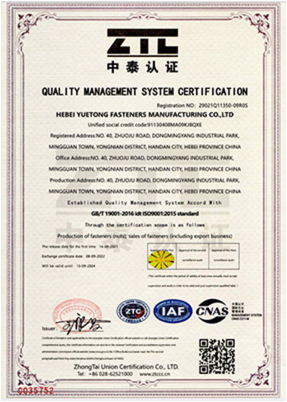Dec . 06, 2024 22:52 Back to list
types of beam clamps
Understanding the Different Types of Beam Clamps
Beam clamps are essential tools in construction and engineering, providing a safe and secure method for suspending various loads from beams. They are used in a variety of applications, including overhead piping, lighting, ductwork, and temporary support for machinery. Understanding the different types of beam clamps available can help you make an informed decision when selecting the right clamp for your project. In this article, we will explore the various types of beam clamps, their applications, and key considerations for choosing the ideal clamp.
1. Fixed Beam Clamps
Fixed beam clamps are designed to provide a permanent attachment point on a structural beam. These clamps are often used in applications where a steady, unchanging connection is required. Fixed beam clamps are typically bolted or welded to the beam and can support a variety of loads. They are commonly used in construction for hanging heavy equipment or piping.
Applications - Supporting ductwork and piping in industrial settings - Hanging lighting fixtures in commercial buildings - Temporary support for construction equipment
2. Adjustable Beam Clamps
As the name suggests, adjustable beam clamps offer flexibility in terms of positioning and load distribution. These clamps can be easily adjusted to fit different beam sizes and can accommodate changes in load requirements. Adjustable beam clamps are especially useful in construction projects where beam dimensions or loads may vary over time.
Applications - Construction sites with varying beam sizes - Hanging equipment that may need to be relocated - Temporary support structures during construction phases
3. Swivel Beam Clamps
Swivel beam clamps feature a rotating design that allows for multi-directional positioning. This capability is particularly useful when the load needs to be positioned at different angles or when it needs to be easily maneuvered. Swivel clamps are often used in situations where precision in positioning is critical.
Applications - Theatre rigging for stage lights and equipment - Suspension of mobile machinery or equipment - Adjusting rigging configurations in dynamic environments
types of beam clamps

4. Pipe Beam Clamps
Pipe beam clamps are specifically designed to secure pipe systems to beams. These clamps are typically curved, allowing them to fit snugly around pipes of various diameters. They are often used in plumbing, HVAC, and other mechanical systems where pipes need to be supported overhead.
Applications - Supporting gas, water, or HVAC piping systems - Attaching pipe hangers to structural beams - Creating a secure connection for pipelines in industrial environments
5. Safety Beam Clamps
Safety beam clamps are engineered to provide an additional level of safety when suspending loads. These clamps often include features such as locking mechanisms or safety latches to prevent accidental release of the load. They are particularly important in high-risk environments where load failure could lead to severe consequences.
Applications - Construction sites with heavy lifting - Industrial settings with high overhead loads - Temporary rigging for theatrical productions
Key Considerations When Choosing Beam Clamps
When selecting a beam clamp for your project, there are several important factors to consider
- Load Capacity Ensure that the clamp you choose can safely support the intended load. Always check the manufacturer's specifications for weight limits. - Beam Size Different clamps are designed for specific beam sizes and shapes. Make sure to measure your beams accurately and select a clamp that fits correctly. - Material The material of the clamp can affect its strength and durability. Consider the environment in which the clamp will be used when selecting materials (e.g., stainless steel for outdoor applications). - Ease of Installation Some clamps are easier to install and adjust than others. If time is a factor, look for clamps that allow for quick and straightforward installation. - Safety Features Consider any necessary safety features based on the application, particularly when working at heights or with heavy loads.
Conclusion
Beam clamps play a crucial role in various industrial and construction applications, providing secure attachment points for a range of loads. By understanding the different types of beam clamps available, you can select the appropriate clamp for your specific needs, ensuring safety and efficiency in your project. Always prioritize load capacity, beam compatibility, material selection, and safety features to achieve optimal results.


